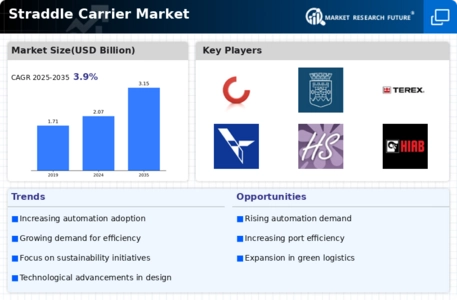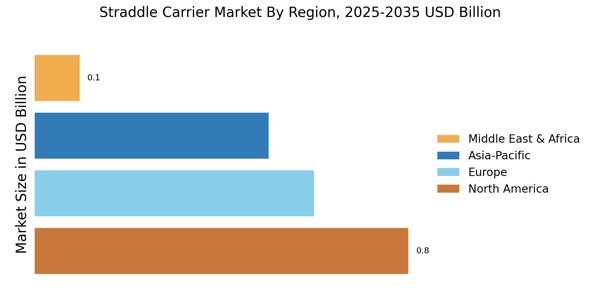Sustainability Initiatives in Straddle Carrier Market
Sustainability initiatives are becoming increasingly pivotal within the Straddle Carrier Market. As environmental regulations tighten, companies are compelled to adopt greener practices. The shift towards electric and hybrid straddle carriers is indicative of this trend, as these vehicles produce fewer emissions compared to their diesel counterparts. Recent statistics suggest that the market for electric straddle carriers is expected to grow at a compound annual growth rate of 20% through 2030. This growth is fueled by both regulatory pressures and a rising consumer preference for sustainable logistics solutions. Additionally, companies are investing in energy-efficient technologies and practices, which not only comply with environmental standards but also enhance operational efficiency. The emphasis on sustainability is likely to influence purchasing decisions, making it a critical driver in the Straddle Carrier Market.
Technological Advancements in Straddle Carrier Market
The Straddle Carrier Market is experiencing a notable transformation due to rapid technological advancements. Innovations such as automation and telematics are enhancing operational efficiency and safety. For instance, the integration of IoT devices allows for real-time monitoring of equipment performance, which can lead to predictive maintenance and reduced downtime. According to recent data, the adoption of automated straddle carriers is projected to increase by approximately 25% over the next five years, driven by the need for improved logistics and supply chain management. Furthermore, advancements in battery technology are enabling electric straddle carriers to become more viable, reducing carbon emissions and operational costs. This technological evolution is likely to reshape the competitive landscape of the Straddle Carrier Market, as companies that invest in these innovations may gain a significant edge over their competitors.
Increased Demand for Efficiency in Straddle Carrier Market
The Straddle Carrier Market is witnessing an increased demand for efficiency, driven by the need for streamlined operations in logistics and transportation. As global trade continues to expand, the pressure on port and terminal operators to optimize their operations intensifies. Straddle carriers, known for their versatility and speed, are becoming essential in meeting these demands. Recent market analysis indicates that the efficiency of straddle carriers can reduce loading and unloading times by up to 30%, significantly enhancing throughput. This efficiency is particularly crucial in high-volume environments, where delays can lead to substantial financial losses. Consequently, the demand for advanced straddle carriers that offer improved performance and reliability is likely to rise, positioning efficiency as a key driver in the Straddle Carrier Market.
Expansion of Port Infrastructure in Straddle Carrier Market
The expansion of port infrastructure is a critical driver in the Straddle Carrier Market. As trade volumes increase, ports are investing heavily in upgrading their facilities to accommodate larger vessels and higher cargo volumes. This expansion often includes the acquisition of new straddle carriers to enhance cargo handling capabilities. Recent reports indicate that several major ports are planning significant investments in infrastructure, with some allocating billions of dollars for modernization projects. This trend is expected to create a robust demand for straddle carriers, as ports seek to improve their operational efficiency and reduce turnaround times. The ongoing development of port infrastructure is likely to stimulate growth in the Straddle Carrier Market, as operators look to leverage advanced equipment to meet the evolving demands of global trade.
Rising E-commerce and Logistics Sector in Straddle Carrier Market
The rising e-commerce and logistics sector is significantly influencing the Straddle Carrier Market. As online shopping continues to gain traction, the demand for efficient logistics solutions has surged. Straddle carriers play a vital role in facilitating the swift movement of goods within distribution centers and ports. Recent data suggests that the logistics sector is projected to grow at a rate of 15% annually, driven by the e-commerce boom. This growth necessitates the adoption of advanced material handling equipment, including straddle carriers, to ensure timely deliveries and efficient operations. Companies are increasingly recognizing the importance of investing in modern straddle carriers to enhance their logistics capabilities. The interplay between the growth of e-commerce and the Straddle Carrier Market is likely to create new opportunities for manufacturers and operators alike.


















Leave a Comment